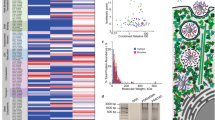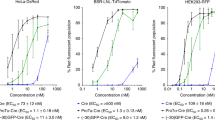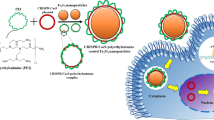Abstract
Polylysine (pLy) has been used as a DNA carrier in nonviral gene delivery systems because it forms complexes with plasmid DNA via charge interaction, and condenses it into a compact structure. We have recently shown that cross-linking nuclear localization sequences (NLSs) to pLy can enhance transfection by conferring specific recognition by the cellular nuclear import ‘receptor’, the NLS-binding importin α/β heterodimer. The present study examines and correlates for the first time the effect of the lysine/nucleotide (Ly/Nu) ratio on transfection, recognition by importin α/β, and structure as determined using electron microscopy (EM) and atomic force microscopy (AFM), for pLy–DNA complexes with and without NLSs or mutant versions thereof. Intriguingly, we observed two distinct peaks of transfection enhancement at Ly/Nu ratios of 0.4 and 4.0, attributable to specific NLS recognition by importins and DNA compaction, respectively. The results indicate a clear correlation between the pLy–DNA structure, importin α/β recognition, and gene transfer efficiency, thus underlining the importance of using pLy–DNA at the optimal Ly/Nu ratio.
This is a preview of subscription content, access via your institution
Access options
Subscribe to this journal
Receive 12 print issues and online access
$259.00 per year
only $21.58 per issue
Buy this article
- Purchase on Springer Link
- Instant access to full article PDF
Prices may be subject to local taxes which are calculated during checkout






Similar content being viewed by others
References
Wagner E, Cotten M, Foisner R, Birnstiel ML . Transferrin-polycation–DNA complexes: the effect of polycations on the structure of the complex and DNA delivery to cells Proc Natl Acad Sci USA 1991 88: 4255–4259
Wu GY, Wu CH . Receptor mediated gene delivery and expression in vivo J Biol Chem 1988 263: 14621–14624
Hart SL et al. Gene delivery and expression mediated by an integrin-binding peptide Gene Therapy 1995 2: 552–554
Rosenkranz AA et al. Receptor-mediated endocytosis and nuclear transport of a transfecting DNA construct Exp Cell Res 1992 199: 323–329
Ferkol T, Perales JC, Mularo F, Hanson RW . Receptor-mediated gene transfer into macrophages Proc Natl Acad Sci USA 1996 93: 101–105
Sosnowski BA et al. Targeting DNA to cells with basic fibroblast growth factor (FGF2) J Biol Chem 1996 271: 33647–33653
Baeza I et al. Electron microscopy and biochemical properties of polyamine-compacted DNA Biochemistry 1987 26: 6387–6392
Perales JC et al. Gene transfer in vivo: sustained expression and regulation of genes introduced into the liver by receptor-targeted uptake Proc Natl Acad Sci USA 1994 91: 4086–4090
Vitiello L et al. Condensation of plasmid DNA with polylysine improves liposome-mediated gene transfer into established and primary muscle cells Gene Therapy 1996 3: 396–404
Perales JC et al. Biochemical and functional characterization of DNA complexes capable of targeting genes to hepatocytes via the asialoglycoprotein receptor J Biol Chem 1997 272: 7398–7407
Ziady AG et al. Chain length of the polylysine in receptor-targeted gene transfer complexes affects duration of reporter gene expression both in vitro and in vivo J Biol Chem 1999 274: 4908–4916
Chan CK, Jans DA . Enhancement of polylysine-mediated transferrinfection by nuclear localization sequences: polylysine does not function as a nuclear localization sequence Hum Gene Ther 1999 10: 1695–1702
Southern PJ, Berg P . Transformation of mammalian cells to antibiotic resistance with a bacteria gene under control of the SV40 early region promoter J Mol App Gen 1982 1: 327–341
Hall CV, Jacob PE, Ringold GM, Lee F . Expression and regulation of Escherichia coli lacZ1 gene fusions in mammalian cells J Mol Appl Genet 1983 2: 101–109
Hubner S, Xiao CY, Jans DA . The protein kinase CK2 site (Ser111/112) enhances recognition of the simian virus 40 large T-antigen nuclear localization sequence by importin J Biol Chem 1997 272: 17191–17195
Bustamante C et al. Circular DNA molecules imaged in air by scanning force microscopy Biochemistry 1992 31: 22–26
Hansma HG et al. DNA condensation for gene therapy as monitored by atomic force microscopy Nucleic Acids Res 1998 26: 2481–2487
Feldherr CM, Akin D . EM visualization of nucleocytoplasmic transport processes Electron Microsc Rev 1990 3: 73–86
Feldherr CM, Akin D . The location of the transport gate in the nuclear pore complex J Cell Sci 1997 110: 3065–3070
Page RL et al. Transgenesis in mice by cytoplasmic injection of polylysine/DNA mixtures Transgenic Res 1995 4: 353–360
Pollard H et al. Polyethylenimine but not cationic lipids promotes transgene delivery to the nucleus in mammalian cells J Biol Chem 1998 273: 7507–7511
Goldberg MW, Allen TD . High resolution scanning electron microscopy of the nuclear envelope: demonstration of a new, regular, fibrous lattice attached to the baskets of the nucleoplasmic face of the nuclear pores J Cell Biol 1992 119: 1429–1440
Akey CW . Visualization of transport-related configurations of the nuclear pore transporter Biophys J 1990 58: 341–355
Wagner E et al. Transferrin–polycation conjugates as carriers for DNA uptake into cells Proc Natl Acad Sci USA 1990 87: 3410–3414
Ma C, Bloomfield VA . Condensation of supercoiled DNA induced by MnCl2 Biophys J 1994 67: 1678–1681
Okayama H, Chen C . In M Ej (ed) Methods in Molecular Biology, Vol 7: Gene Transfer and Expression protocols Humana Press: Clifton, NJ 1991 pp 15–21
Chan CK, Hubner S, Hu W, Jans DA . Mutual exclusivity of DNA binding and nuclear localization signal recognition by the yeast transcription factor GAL4: implications for nonviral DNA delivery Gene Therapy 1998 5: 1204–1212
Xiao CY, Hubner S, Jans DA . SV40 large tumor antigen nuclear import is regulated by the double-stranded DNA-dependent protein kinase site (serine 120) flanking the nuclear localization sequence J Biol Chem 1997 272: 22191–22198
Jans DA et al. p34cdc2-mediated phosphorylation at T124 inhibits nuclear import of SV40 T-antigen proteins J Cell Biol 1991 115: 1203–1212
Xiao CY et al. A consensus cAMP-dependent protein kinase (PK-A) site in place of the CcN motif caesin kinase II site of Simian virus 40 large T-antigen confers PK-A mediated regulation of nuclear import J Biol Chem 1996 271: 6451–6457
Tyler JM, Branton D . Rotary shadowing of extended molecules dried from glycerol J Ultrastruct Res 1980 71: 95–102
Author information
Authors and Affiliations
Rights and permissions
About this article
Cite this article
Chan, CK., Senden, T. & Jans, D. Supramolecular structure and nuclear targeting efficiency determine the enhancement of transfection by modified polylysines. Gene Ther 7, 1690–1697 (2000). https://doi.org/10.1038/sj.gt.3301275
Received:
Accepted:
Published:
Issue Date:
DOI: https://doi.org/10.1038/sj.gt.3301275
Keywords
This article is cited by
-
Enhancing Cell Nucleus Accumulation and DNA Cleavage Activity of Anti-Cancer Drug via Graphene Quantum Dots
Scientific Reports (2013)
-
Strategies in the design of nanoparticles for therapeutic applications
Nature Reviews Drug Discovery (2010)
-
Design and development of polymers for gene delivery
Nature Reviews Drug Discovery (2005)



